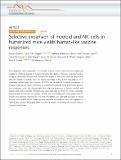| dc.contributor.author | Douam, Florian | |
| dc.contributor.author | Hrebikova, Gabriela | |
| dc.contributor.author | Fant, Bruno | |
| dc.contributor.author | Leach, Robert | |
| dc.contributor.author | Parsons, Lance | |
| dc.contributor.author | Wang, Wei | |
| dc.contributor.author | Gaska, Jenna M. | |
| dc.contributor.author | Winer, Benjamin Y. | |
| dc.contributor.author | Heller, Brigitte | |
| dc.contributor.author | Ploss, Alexander | |
| dc.contributor.author | Ziegler, Carly | |
| dc.contributor.author | Shalek, Alexander K | |
| dc.date.accessioned | 2019-03-07T15:34:44Z | |
| dc.date.available | 2019-03-07T15:34:44Z | |
| dc.date.issued | 2018-11 | |
| dc.identifier.issn | 2041-1723 | |
| dc.identifier.uri | http://hdl.handle.net/1721.1/120790 | |
| dc.description.abstract | Mice engrafted with components of a human immune system have become widely-used models for studying aspects of human immunity and disease. However, a defined methodology to objectively measure and compare the quality of the human immune response in different models is lacking. Here, by taking advantage of the highly immunogenic live-attenuated yellow fever virus vaccine YFV-17D, we provide an in-depth comparison of immune responses in human vaccinees, conventional humanized mice, and second generation humanized mice. We demonstrate that selective expansion of human myeloid and natural killer cells promotes transcriptomic responses akin to those of human vaccinees. These enhanced transcriptomic profiles correlate with the development of an antigen-specific cellular and humoral response to YFV-17D. Altogether, our approach provides a robust scoring of the quality of the human immune response in humanized mice and highlights a rational path towards developing better pre-clinical models for studying the human immune response and disease. | en_US |
| dc.description.sponsorship | National Institute of General Medical Sciences (U.S.) (Award T32GM007753) | en_US |
| dc.description.sponsorship | Searle Scholars Program | en_US |
| dc.description.sponsorship | Arnold and Mabel Beckman Foundation (Young Investigator Program) | en_US |
| dc.description.sponsorship | National Institutes of Health (U.S.) (1DP2OD020839) | en_US |
| dc.description.sponsorship | National Institutes of Health (U.S.) (5U24AI118672) | en_US |
| dc.description.sponsorship | National Institutes of Health (U.S.) (1U54CA217377) | en_US |
| dc.description.sponsorship | National Institutes of Health (U.S.) (1R33CA202820) | en_US |
| dc.description.sponsorship | National Institutes of Health (U.S.) (2U19AI089992) | en_US |
| dc.description.sponsorship | National Institutes of Health (U.S.) (21R01HL134539) | en_US |
| dc.description.sponsorship | National Institutes of Health (U.S.) (2RM1HG006193) | en_US |
| dc.description.sponsorship | National Institutes of Health (U.S.) (2R01HL095791) | en_US |
| dc.description.sponsorship | National Institutes of Health (U.S.) (P01AI039671) | en_US |
| dc.description.sponsorship | Bill & Melinda Gates Foundation (OPP1139972) | en_US |
| dc.publisher | Nature Publishing Group | en_US |
| dc.relation.isversionof | http://dx.doi.org/10.1038/s41467-018-07478-2 | en_US |
| dc.rights | Creative Commons Attribution 4.0 International license | en_US |
| dc.rights.uri | https://creativecommons.org/licenses/by/4.0/ | en_US |
| dc.source | Nature | en_US |
| dc.title | Selective expansion of myeloid and NK cells in humanized mice yields human-like vaccine responses | en_US |
| dc.type | Article | en_US |
| dc.identifier.citation | Douam, Florian, Carly G. K. Ziegler, Gabriela Hrebikova, Bruno Fant, Robert Leach, Lance Parsons, Wei Wang, et al. “Selective Expansion of Myeloid and NK Cells in Humanized Mice Yields Human-Like Vaccine Responses.” Nature Communications 9, no. 1 (November 28, 2018). © 2018 The Authors | en_US |
| dc.contributor.department | Massachusetts Institute of Technology. Institute for Medical Engineering & Science | en_US |
| dc.contributor.department | Harvard University--MIT Division of Health Sciences and Technology | en_US |
| dc.contributor.department | Ragon Institute of MGH, MIT and Harvard | en_US |
| dc.contributor.department | Koch Institute for Integrative Cancer Research at MIT | en_US |
| dc.contributor.mitauthor | Ziegler, Carly | |
| dc.contributor.mitauthor | Shalek, Alexander K | |
| dc.relation.journal | Nature Communications | en_US |
| dc.eprint.version | Final published version | en_US |
| dc.type.uri | http://purl.org/eprint/type/JournalArticle | en_US |
| eprint.status | http://purl.org/eprint/status/PeerReviewed | en_US |
| dc.date.updated | 2019-03-04T14:52:02Z | |
| dspace.orderedauthors | Douam, Florian; Ziegler, Carly G. K.; Hrebikova, Gabriela; Fant, Bruno; Leach, Robert; Parsons, Lance; Wang, Wei; Gaska, Jenna M.; Winer, Benjamin Y.; Heller, Brigitte; Shalek, Alex K.; Ploss, Alexander | en_US |
| dspace.embargo.terms | N | en_US |
| dc.identifier.orcid | https://orcid.org/0000-0002-8279-7150 | |
| dc.identifier.orcid | https://orcid.org/0000-0001-5670-8778 | |
| mit.license | PUBLISHER_CC | en_US |
